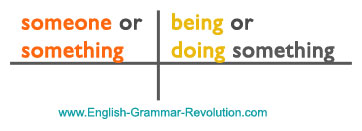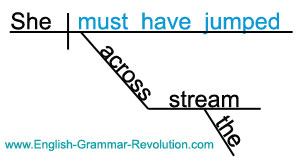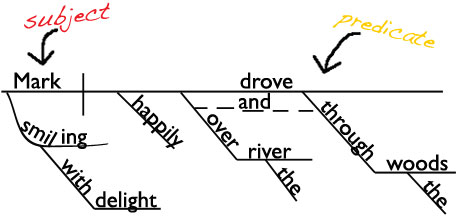Download your free grammar guide here.
Download your free grammar guide here.
Five Steps For Learning Grammar
Five Steps For Learning Grammar
- Home
- 5 Steps For Learning Grammar
Learning grammar can seem like a hugely intimidating task. I know this because I struggled to learn grammar throughout college and during my first few years as a classroom teacher.
 You have the power to silence your inner critic.
You have the power to silence your inner critic.Now that I run this website, I hear from people (students and adults alike) who feel self-conscious about their lack of grammar knowledge. This self-consciousness stops them from expressing themselves, and it makes them feel like they're not good enough for the life that they want.
Here's the wonderful thing: you have the power to stop this self-criticism. You just need a little bit of guidance to help you learn the right things in the right order.
Once you have that, in a relatively short period of time, you can conquer this subject and reclaim your confidence.
That's the experience I had when I finally learned grammar, and it has been echoed by hundreds of others who have reached out to me after they completed my Get Smart Grammar Program or followed the five steps below.
Are you ready? Of course you are! Here is your step-by-step plan for learning grammar.
Step 1. Study the parts of speech.
We humans like to categorize things. Just think about the way we arrange items in grocery stores, libraries, and our closets. We group together things that are alike.
Our compulsion to organize everything around us doesn't end with physical items (food, clothing, books, etc.). It continues into the realm of the non-physical (emails, photos, files, etc.). It should come as no surprise, then, that people categorize words into groups called the parts of speech.
Learning grammar starts by learning about each part of speech.
The Eight Parts of Speech
Here is a list of the eight parts of speech along with a short description of each one.
|
1. Nouns name people, places, things, and ideas. 2. Pronouns take the place of nouns. 3. Verbs name an action or a state of being. 4. Adjectives modify nouns. |
5. Adverbs modify verbs, adjectives, and other adverbs. 6. Prepositions hook nouns onto sentences. 7. Conjunctions connect things. 8. Interjections express emotion. |
Action Step
Learn about each part of speech with the lessons and links on the parts of speech page. You'll find more detailed information, examples, and sentence diagrams for the parts of speech. Completing this step usually takes some time (especially if you're not following a specific program), so don't feel rushed. Perhaps you could commit to learning about one part of speech a day, or one a week. In the long run, your pace doesn't matter. It just matters that you keep going. :)
Tip: If you want to learn about the parts of speech and basic sentence diagramming in under an hour, sign up for my free grammar newsletter. As a bonus for signing up, I'm currently offering access to a 50-minute video lecture where I'll diagram the Preamble of the Constitution with you. I think you'll be pleasantly surprised by how much you'll learn. (You might even enjoy yourself too!)
Step 2. Learn what makes up a sentence.
Now that you have a general understanding of the word categories (parts of speech), it's time for us to start putting words together to create sentences!
Have you ever considered what a group of words needs in order to be a sentence?
All complete sentences must contain a subject (someone or something) and a verb (an action or a state of being). They must also express a complete thought.
Would you like to know something cool about what you just read? There are countless sentences floating around out there in the world, and they can all be boiled down to this:
Someone or Something Doing or Being Something
That's it! That's the idea behind every sentence! When we diagram sentences (which is a way of making the grammar of a sentence visual), we put these two basic parts on lines like this:

While there is a lot more that you can learn about different sentence structures and sentence purposes, you've just learned the most basic and important thing about them.
Action Step
Watch the short video lesson and read the written lesson on the sentence construction page. There, I'll show you more about how sentence diagrams and sentences work.
Step 3. Study phrases.
This is where learning grammar starts to get fun! You know that words are units of language, and we can categorize them into groups called the parts of speech.
Here's the fun thing: phrases are also units of language. They are groups of words, but they come together to function as a single unit. That means that instead of one word functioning as a part of speech, a whole group of words (a phrase) can function as a single part of speech. Isn't that crazy?
Another thing to know about phrases is that they do not contain a subject and a verb.
Let's look at an example.
She jumped across the stream.
Jumped is a word. It's a verb.
She must have jumped across the stream.
Must have jumped is a phrase. It's a group of words that does not contain a subject and a verb, and all of the words together are acting as the verb in this sentence.

This picture shows you a sentence diagram that contains the verb phrase we just looked at. The words in blue are all individual words, but they are coming together to perform the job of one part of speech. (Notice that all of the words are in one slot in the sentence diagram. This slot is made just for verbs.)
Since this phrase is functioning as the verb, we call it a verb phrase.
Action Step
Go to the phrases page and learn more about phrases and the ways that they can function. If you're a beginner, focus only on verb phrases and prepositional phrases for now.
Step 4. Study clauses.
Now that you know that words and phrases are units of language, the next step for learning grammar is to study another unit of language: clauses. Clauses are groups of words that do contain a subject and a verb. (Remember that phrases don't contain a subject and a verb.)
Some clauses can stand alone as complete thoughts. These kinds of clauses are called independent clauses.
I smiled.
I smiled is an independent clause. It contains a subject (I) and a verb (smiled), and it can stand alone as a complete thought.
Other clauses can't stand alone as complete thoughts. We call them dependent clauses.
I smiled when Alice sang.
When Alice sang is a dependent clause. It contains a subject (Alice) and a verb (sang), and it can't stand alone as a complete thought. It needs to be attached to an independent clause (I smiled) in order to make sense.
Action Step
There's a lot more to learn about independent and dependent clauses! Go to the clauses page and use the information and links there to study more about clauses and to learn how to diagram them.
Step 5. Learn how to diagram sentences.
Sentence diagramming should be a part of everyone's plan for learning grammar. Sentence diagrams will help you understand concepts and retain what you learn for years to come. Ideally, you'll sprinkle your sentence diagramming lessons throughout the first four steps.
You'll start with sentence diagrams like this.

And you'll gradually be making sentence diagrams like this.

Action Step
You can start learning some basic diagramming with these sentence diagramming exercises.
Step 6. Streamline your studies.
You can certainly learn grammar and sentence diagramming by going through the steps and links on this website. Use the steps and links above, and you'll be on your way!
However, if you want to streamline and automate your learning, you should check out our Get Smart Grammar Program. In it, I teach you all of the topics listed above (and more) through short video and written lessons that are very easy to follow.
The program also contains exercises and quizzes to test yourself along the way. The lessons are broken down into manageable chunks, and all you need to do is go through the lessons in order.
Action Step
Make this whole process easier by using our video lessons and grammar exercises in our most popular program, the Get Smart Grammar Program.
I have to tell you how much I love your product [Get Smart]. I have struggled with understanding grammar my whole life, and I felt like I was stupid because I could not memorize the rules.
I was seriously leaning towards walking away from my dream job as a college professor because of my embarrassment and fear of getting caught as being a fraud! Thank God for you! I have confidence, and I actually love grammar now. Thank you for everything!
- Carly, College Professor
Thanks for being here! I hope that these steps helped to solidify your plan for learning grammar. :)
Other Helpful Resources
- If you're wondering why learning grammar wasn't a part of your school experience, you would probably enjoy our documentary, Grammar Revolution, which is currently streaming free on YouTube.
This is original content from https://www.english-grammar-revolution.com/learning-grammar.html

Hello! I'm Elizabeth O'Brien, and my goal is to get you jazzed about grammar.
Our Free Guide Gives You A Fun Way
To Teach And Learn The Basics v

Elizabeth O'Brien is the creator of Grammar Revolution.
Her lessons are guaranteed to give you more confidence in your communication skills and make you smile. :)
